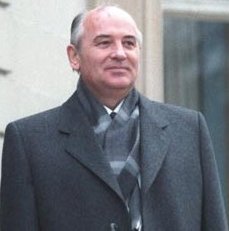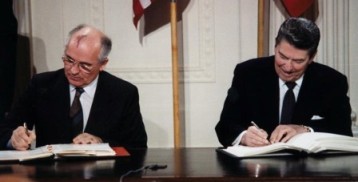Mikhail Gorbachev
Biography >>
Cold War

Mikhail Gorbachev
- Occupation: Leader of the Soviet Union
- Born: March 2, 1931
- Best known for: Bringing reform to the Soviet Union and helping to end the Cold War.
- Nickname: The Marked One
Mikhail Gorbachev was the last leader of the Soviet Union before it dissolved in 1991. He brought many reforms to the Soviet Union including new freedoms which eventually led to many countries breaking away from the union claiming independence. His relationships with western leaders such as Ronald Reagan and Margaret Thatcher helped bring an end to the Cold War.
Where did Mikhail grow up?
Mikhail was born in Stavropol, Russia on March 2, 1931. His parents both worked in agriculture. Mikhail also worked in agriculture while attending school. His childhood was filled with difficult events. In 1933 a famine swept through much of Russia. Two of his sisters and an uncle died during the famine. In 1937 his grandfather was arrested for supporting the followers of Leon Trotsky. Later, in 1942, his town was occupied by the Germans in World War II.
In 1950 Mikhail went to Moscow University where he received a degree in law. He also met his wife Raisa Titorenko there and joined the Communist Party of the Soviet Union (CPSU).
Rising in the Communist Party
After graduating in 1955, Gorbachev first worked as a member of the Communist Youth Organization. He became the leader of the division in Stavropol. In 1961 he was selected to be the delegate for Stavropol at the 22nd Communist Party Congress in Moscow.
Over the next several years Gorbachev became a leader in the Communist Party. First, in 1970, he became First Secretary for the entire Stavropol territory. Then, 1971, he moved to Moscow as the Secretary of Agriculture.
Mikhail quickly became a force in Moscow gaining influence with such powerful leaders as Yuri Andropov (KGB leader who later became leader of the Soviet Union). In 1980 Gorbachev was selected to be a member of the Politburo, the most powerful group in the Communist Party. He was the youngest member of the Politburo.
Becoming the Leader of the Soviet Union
Within a few short years, Gorbachev gained considerable influence on the Politburo. After two aging leaders died in 1984 and 1985, the Communist Party wanted someone young and healthy to take over as leader. On March 11, 1985 Mikhail Gorbachev became the General Secretary of the Soviet Union.
When Gorbachev took over as leader, the Soviet economy was struggling. He wanted to reform the economy as well as the government. In order to do this he needed support, so he began to replace some of the older members of the politburo with younger men who shared his vision.
Glasnost and Perestroika
Gorbachev announced two main areas of reform. He called them Glasnost and Perestroika. Glasnost called for increased openness in government. It also allowed for some freedom of speech and less censorship. Perestroika was a restructuring of the economy and industry. It allowed for some private ownership and economic reforms to try and improve the Soviet economy.
Peace with the West
Gorbachev also made attempts to end the Cold War and improve relations with the west. He met with US President Ronald Reagan and signed the INF treaty regarding nuclear weapons. He also removed Soviet troops from Afghanistan ending the Soviet Afghanistan War.

Gorbachev and Reagan signing the INF treaty
Gorbachev also indicated that the Soviet Union would no longer interfere with other countries in Eastern Europe. This caused a major change in the world. Without the fear of the Soviet Union, countries such as Eastern Germany, Poland, and Hungary got rid of their communist governments. In 1989 the Berlin Wall in Germany was torn down.
1991 Coup Attempt
In August of 1991, communist "hardliners" who didn't agree with Gorbachev's reforms tried to take over the government. They kidnapped Gorbachev and said he was sick and couldn't rule. Soon protests grew and Gorbachev was set free, but the damage to the government had been done.
Collapse of the Soviet Union
Although Gorbachev's reforms allowed for more freedom, many states used this freedom to protest and eventually claim independence from the Soviet Union. By the end of 1991, the Soviet Union had collapsed. On December 25, 1991 Gorbachev resigned as leader of the Soviet Union and the Union was split into 15 separate countries.
Later Activities
Since resigning Gorbachev has remain involved in politics. He started new political parties in Russia and even ran for president in 1996 (he didn't win). Recently he has criticized the rule of President Vladimir Putin.
Interesting Facts About Gorbachev
- He was heavily influenced by his grandfather who taught him about Marxism and Lenin.
- He had one child, a daughter named Irina.
- Gorbachev has received many awards for his work including the St. Andrew Award from Russia, the Ronald Reagan Freedom Award, the Indira Gandhi Prize, and the Nobel Peace Prize (1990).
- He has a large birth mark on his forehead which led to the nickname "The Marked Man".
- He was in a Pizza Hut commercial in 1997 with his granddaughter Anastasia.
- He once said "If what you have done yesterday still looks big to you, you haven't done much today."
- http://www.ducksters.com/biography/world_leaders/mikhail_gorbachev.php

No comments:
Post a Comment